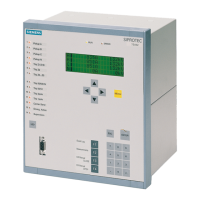2 Functions
246
7SD5 Manual
C53000-G1176-C169-1
Figure 2-110 Possible unfavourable current distribution on a three terminal line during an ex-
ternal earth fault
Time Settings The send signal prolongation Send Prolong.(address 3203) must ensure that the
send signal reliably reaches the opposite line end, even if there is very fast tripping at
the sending line end and/or the signal transmission time is relatively long. In the case
of the permissive schemes Dir.Comp.Pickup and UNBLOCKING, this signal prolon-
gation time is only effective if the device has already issued a trip command. This
ensures the release of the other line end even if the short-circuit is cleared very rapidly
by a different protection function or other stage. In the case of the blocking scheme
BLOCKING, the transmit signal is always prolonged by this time. In this case, it corre-
sponds to a transient blocking following a reverse fault. This parameter can only be
altered with DIGSI
®
under Additional Settings.
In order to detect steady-state line faults such as open circuits, a monitoring time
Delay for alarm is started when a fault is detected (address 3207). Upon expira-
tion of this time the fault is considered a permanent failure. This setting is only possible
via DIGSI
®
at Additional Settings.
The release of the directional tripping can be delayed by means of the permissive
signal delay Release Delay (address 3208). In general, this is only required for the
blocking scheme BLOCKING to allow sufficient transmission time for the blocking
signal during external faults. This delay only has an effect on the receive circuit of the
teleprotection. Conversely, tripping by the comparison protection is not delayed by the
set time delay of the directional stage.
Transient Blocking The setting parameters TrBlk Wait Time and TrBlk BlockTime are for the tran-
sient blocking with the comparison schemes. This setting is only possible via DIGSI
®
at Additional Settings.
The time TrBlk Wait Time (address 3209) is a waiting time prior to transient block-
ing. In the case of the permissive schemes, only once the directional stage of the earth
fault protection has recognized a fault in the reverse direction, within this period of time
after fault detection, will the transient blocking be activated. In the case of the blocking
scheme, the waiting time prevents transient blocking in the event that the blocking
signal reception from the opposite line end is very fast. With the setting ∞ there is no
transient blocking.
The transient blocking time TrBlk BlockTime (address 3210) must definitely be set
longer than the duration of severe transients resulting from the inception or clearance
of external faults. The send signal is delayed by this time with the permissive over-
reach schemes Dir.Comp.Pickup and UNBLOCKING if the protection had initially
detected a reverse fault. In the case of the blocking scheme BLOCKING the received
(blocking) signal is prolonged by this time.
The preset value should be sufficient in most cases.
www . ElectricalPartManuals . com
